Frater D.D.C.F.

ONE
The figures of Geomancy consist of various groupings of odd and even points in 4 lines. Of these the greatest possible number of combinations is 16. Therefore these sixteen combinations of odd and even points arranged on four lines are the sixteen figures of Geomancy. These are again classed under the heads of the Elements, the Signs of the Zodiac, and the Planets. Two figures are attributed to each of the Seven Planets, while the remainder are attributed to Caput and Cauda Draconis the Head and Tail of the Dragon, or the North and South Nodes of the Moon. Furthermore, to each Planet and Sign certain ruling Genii are attributed.

TWO
Roughly speaking, the mode of obtaining the first four Geomantic figures, from which the remainder of the Divination is calculated, is by marking down at random on paper with a pencil held by a loosely tensed hand 16 lines of points or dashes, without counting the number placed in each line during the operation. It should be done very rapidly. All the time think fixedly of the subject of the question. When the 16 lines are completed, the number of points in each line should be added up, and if the result be odd a single point or cross should be made in the first of the three compartments to the right of the paper. If even, two points or crosses. These 16 lines are represented below.

These yield four Geomantic figures. The results, odd and/or even, of lines ito 4 inclusive comprise the first figure, of Fortuna Minor. Of lines 5 to 8 the second figure; of lines 9 to 12 the third; of lines 13 to 16, the 4th figure, as shown in the diagram.
PLAN OF GEOMANTIC DIVINATION
The symbol of a Pentagram either within or without a circumscribed circle should be made at the top of the paper on which the dashes are made. The paper itself should be perfectly clean and should have never been previously used for any other purpose. If a circle be used with the Pentagram, it should be drawn before the latter is described. The Pentagram should always be of the “invoking” type, as described in the Pentagram Ritual. Since the Pentagram concerns the element of Earth, it should therefore be drawn beginning at the top point descending to the lower left hand point, carefully closing the angle at the finish. While slowly tracing the Pentagram, the divine name associated with Earth should be intoned or vibrated ADONAI ha-ARETZ. It could be intoned two or three times before proceeding with the drawing of the Sigil. This will help to concentrate the mind and to elevate it to the highest notion compatible with the method. Do remember that in one of the Ritual obligations, the aspirant swears that in all his magical workings he will always invoke the highest divine names that he knows. Thus he will always be working under the aegis of the divine. Within the centre of the Pentagram, the Sigil of the “Ruler” to which the matter of the question specially refers, should be placed.
If the question be of the Nature of Saturn, such as agriculture, sorrow, death, etc., the Sigil of Zazel should be placed in the Pentagram. If of Jupiter, concerning good fortune, feasting, church preferment, etc., the Sigil of Hismael. If of Mars, war, fighting, victory, etc., the Sigil of Bartzabel. If of the Sun, power, magistracy, success, etc., the Sigil of Sorath. If of Venus, love, music, pleasure, etc., the Sigil of Kedemel. If of Mercury, such as science, learning, knavery, etc., the Sigil of Taphthartharath, etc., If of travelling, fishing, etc., under Luna, then the Sigil of Chasmodai. In the diagram appended, the Sigil of Hismael is employed.
During the marking down of the points, the attention should be fixed upon the Sigil within the Pentagram, and the mind should carefully consider the question proposed.
A good idea to to repeat out loud the name of the Ruler as if to invoke him. This should also be followed by a short statement repeated again and again concerning the topic of divination. The hand should not be removed from the paper until all 16 lines of points have been finished.
For example if you wished to ask a question concerning the acquisition of wealth you would use the Sigil relating to Jupiter, Hismael. You would then, while making the random dots, repeat three or four times the name of Hismael, followed by, “Will I acquire, such and such amount of money?” (Specify time period. The phrasing of the question should be very definite and specific.) The whole phrase should be repeated frequently until all 16 lines of dots have been completed.
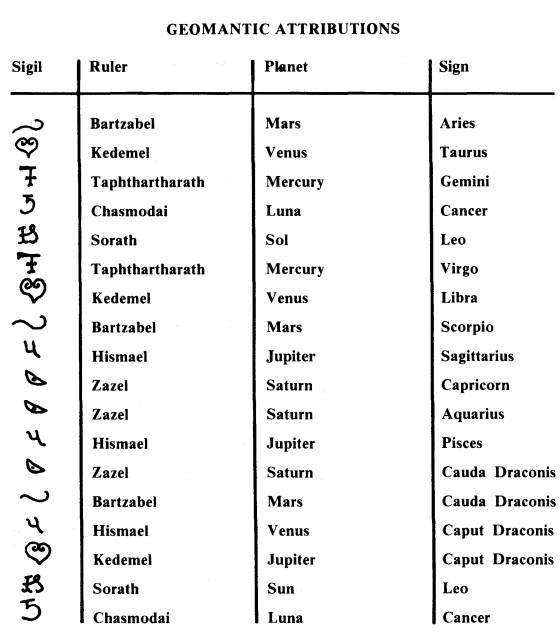
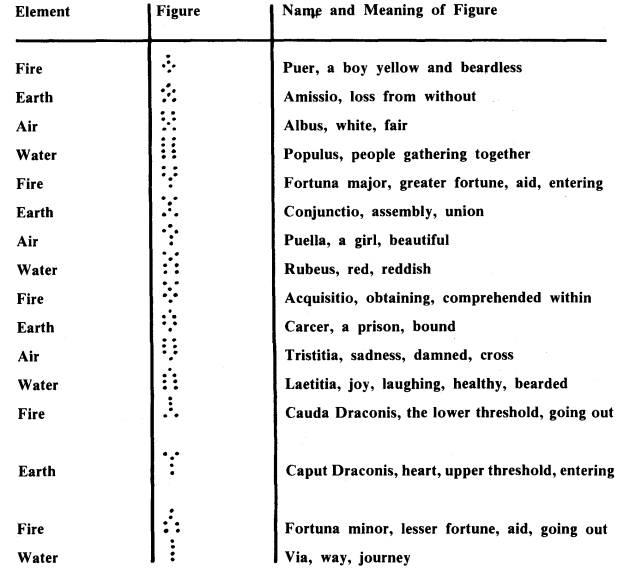
A pencil is preferable to a pen for this task of tracing the dots. Otherwise, use a contemporary felt pen or marking pen which is ideal for this purpose. It is practically more convenient to draw or rule four lines across the paper beforehand to mark off the space for such four lines composing a Geomantic Figure as shown on the previous page.
The first four Geomantic figures formed directly from the 16 lines of points are called The Four Mothers. It is from them that the remaining figures necessary to complete the Geomantic scheme of direction are derived.
These should now be placed in a row from right to left, for the greater convenience of the necessary calculation though much practice may render this unnecessary. The first figure will be attributed to the South, the Second to the East, the Third to the North, and the Fourth to the West.
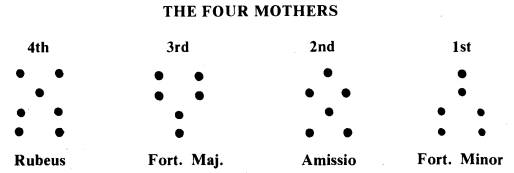
From these Four Mothers, four resulting figures called the Four Daughters are now to be derived, thus: The uppermost points of the First Mother, will be the uppermost points of the First Daughter. The corresponding, that is the first line of, points of the Second Mother will be the second points of the First Daughter. The same line of points of the Third Mother will constitute the third points of the First Daughter. The same points of the Fourth Mother willl be the fourth points of the First Daughter. The same rule applies to all the figures.
The second line of points of the four Mother figures will comprise the Second Daughter. The third line of points of the Four Mothers will comprise the Third Daughter, and the fourth line of points of the Four Mothers will comprise the Fourth Daughter and so on.
Applying the above rule throughout, the following will represent the Four Daughters:

These, again for the convenience of the beginner, are now to be placed on the left hand of the Four Mothers in a single line from right to left.
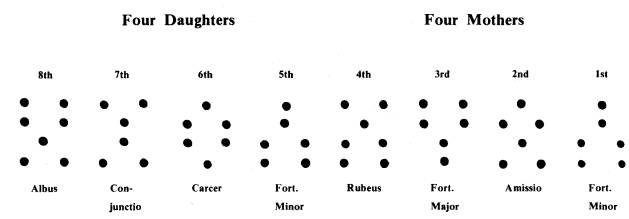
From these eight figures, four others are now to be calculated which may be called the Four Resultants, or the Four Nephews. These will be the 9th, 10th, 11th, and 12th figures of the whole scheme. The Ninth figure is formed from the points of the first and second figures compared together. The Tenth from the 3rd and 4th figures; the 11th from the 5th and 6th figures, the 12th from the 7th and 8th figures. The rule is to compare or add together the points of the corresponding lines. If, for instance, the first line of the First Mother consists of one point, and the first line of the Second Mother also consists of one point, these two are added together, and since they form an even number two points are marked down for the first line of the Resultant. If the added points are odd, only one point is marked for the resulting figure. The Ninth figure of Conjunctio is thus formed.

Now the first figure has one point at the top, the second figure has one point at the top-together they make two, an even number, thus making 2 points for the new figure. The first figure has one point on the second line, and the second figure has two points on the second line. Together they make three points, an odd number, therefore represented by one point in the new figure. The rest follow similarly and is represented again by the figure below.
In this way are yielded the four Resultants:

CONJUNCTIO
The other Resultants are calculated in precisely the same way:
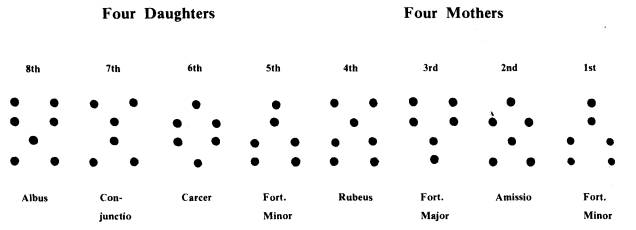
In this way are yielded the four Resultants:

And thus the Twelve Principal Figures of the Geomantic scheme of Divination are completed. These again correspond to the 12 Astrological Houses of Heaven, with which they will later on be compared.

THREE
For the greater assistance of the Diviner in forming a judgment upon the general condition of the scheme of 12 figures thus far obtained, it is usual to deduce from them three other subsidiary figures. These three are of less importance than the twelve previous figures, and are not to be considered at all in the light of component figures of the scheme, but only as aids to the general judgment. These other figures are known as the Right Witness, Left Witness, and the Judge.
The two witnesses are without significance in the divination, except as they are the roots from which the figure known as the Judge is derived. The Right Witness is formed from the 9th and 10th figures by comparing the points in the manner before shown in the formation of the Resultants. That is the corresponding lines of points in the two figures are compared together, and the addition, whether odd or even, comprises the points of the Witness. The Left Witness represents the combination in a similar manner to the 11th and 12th figures. The Judge again is formed in precisely the same way from the Two Witnesses, and is therefore a synthesis of the whole figure.
If he be good, the figure is good and the judgment will be favourable; and vice versa. From the nature of the formation of the 15th figure, the Judge, it should always consist of an even number of points, and never of odd. That is, adding together the four lines of points, comprising the Judge, the result should be an even number. For if the Judge were a figure of odd points it would show that a mistake had been made somewhere in the calculation.
The Reconciler is a 16th figure sometimes used for aiding the Judgment by combining the Judge with the Figure in the Particular House signifying the thing demanded. Thus, in the preceding scheme, the Judge formed is Populus, and the Second Figure, being Amissio, their combination also yields Amissio.
In order to discover where The Part of Fortune will fall, add together all the points of the first twelve figures. Divide that number by twelve, and place the Part of Fortune with the figure answering to the remainder. If there is no remainder it will fall on the 12th figure. The Part of Fortune is a symbol of ready money, money in cash belonging to the Querent, and is of the greatest importance in all questions of money.

FOUR
The following is the signification of the 12 Houses of Heaven, in brief:
First House (Ascendant) = Life, health, querent, etc.
Second House = Money, property, personal worth.
Third House = Brothers, sisters, news, short journeys, etc.
Fourth House = Father, landed property, inheritance. The grave, the end of matter.
Fifth House = Children, pleasure, feasts, speculation.
Sixth House = Servants, sickness, uncles and aunts, small animals.
Seventh House = Love, marriage, husband or wife. Partnerships and associations, public enemies, law suits.
Eighth House = Deaths, wills, legacies; pain, anxiety. Estate of deceased.
Ninth House = Long journeys, voyages. Science, religion, art, visions, and divinations.
Tenth House = Mother. Rank and honour, trade or profession, authority, employment, and worldly position generally.
Eleventh House = Friends, hopes and wishes.
Twelfth House = Sorrows, fears, punishments, secret enemies, hospitals or prisons, unseen dangers, restrictions.
The Twelve figures of the Geomantic scheme as previously calculated are to be attributed to a map of the 12 houses of heaven to be placed therein thus:
The first figure goes in the 10th house.
The second figure goes in the 1st house.
The third figure goes in the 4th house.
The fourth figure goes in the 7th house.
The fifth figures goes in the 11th house.
The sixth figure goes in the 2nd house.
The seventh figure goes in the 5th house.
The eighth figure goes in the 8th house.
The ninth figure goes in the 12th house.
The tenth figure goes in the 3rd house.
The eleventh figure goes in the 6th house.
The twelfth figure goes in the 9th house.
Thus the figures derived by the calculations provided in the example given previously would occupy a Geomantic map as follows:
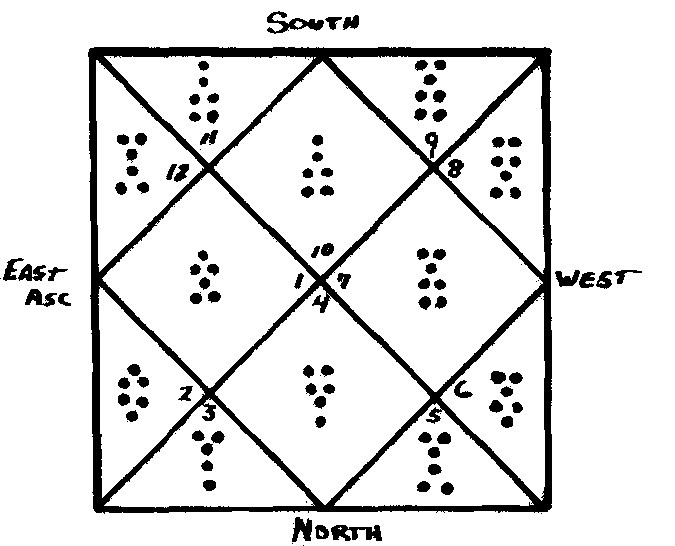

FIVE
Herein follows a set of general Tables of the Sixteen figures in the Twelve Houses for the better convenience of forming a general judgment of the Scheme. Under the head of each figure separately is given its general effect in whatever House of the Map of the Heavens it may be located. Thus, by taking the House signifying the end or result of the matter, the Fourth House, etc., and by noting what figures fall therein, the student may find by these tables the general effect in that position.
ACQUISITIO = Generally good or profit and gain.
- Ascendant - Happy, success in all things.
- Second House - Very prosperous.
- Third House - Favour and riches.
- Fourth House - Good fortune and success.
- Fifth House - Good success,
- Sixth House - Good, especially if it agrees with the 5th.
- Seventh House - Reasonably good.
- Eighth House - Rather good, but not very. The sick shall die.
- Ninth House - Good in all demands.
- Tenth House - Good in suits. Very prosperous.
- Eleventh House - Good in all.
- Twelfth House - Evil, pain and loss.
AMISSIO = Good for loss of substance and sometimes for love; but very bad for gain.
- Ascendant - III in all things but for prisoners.
- Second House - Very ill for money, but good for love.
- Third House - Ill end, except for quarrels.
- Fourth House - Ill in all.
- Fifth House - Evil except for agriculture.
- Sixth House - Rather evil for love.
- Seventh House - Very good for love, otherwise evil.
- Eighth House - Excellent in all questions.
- Ninth House - Evil in all things.
- Tenth House - Evil except for favour with women.
- Eleventh House - Good for love, otherwise bad.
- Twelfth House - Evil in all things.
FORTUNA MAJOR = Good for gain in all things where a person has hopes to win.
- Ascendant - Good save in secrecy.
- Second House - Good except in sad things.
- Third House - Good in all.
- Fourth House - Good in all, but melancholy.
- Fifth House - Very good in all things.
- Sixth House - Very good except for debauchery.
- Seventh House - Good in all.
- Eighth House - Moderately good.
- Ninth House - Very good.
- Tenth House - Exceedingly good. Go to superiors.
- Eleventh House - Very good.
- Twelfth House - Good in all.
FORTUNA MINOR = Good in any matter in which a person wishes to proceed quickly.
- Ascendant - Speed in victory and in love, but choleric.
- Second House - Very good.
- Third House - Good, but wrathful.
- Fourth House - Haste; rather evil except for peace.
- Fifth House - Good in all things.
- Sixth House - Medium in all.
- Seventh House - Evil except for war or love.
- Eighth House - Evil generally.
- Ninth House - Good, but choleric.
- Tenth House - Good, except for peace.
- Eleventh House - Good, especially for love.
- Twelfth House - Good, except for alteration, or for suing another.
LAETITIA = Good for joy, present or to come.
- Ascendant - Good, except in war.
- Second House - Sickly.
- Third House - III.
- Fourth House - Mainly good.
- Fifth House - Excellent.
- Sixth House - Evil generally.
- Seventh House - Indifferent.
- Eighth House - Evil generally.
- Ninth House - Very good.
- Tenth House - Good, rather in war than in peace.
- Eleventh House - Good in all.
- Twelfth House - Evil generally.
TRISTITIA = Evil in almost all things.
- Ascendant - Medium, but good for treasure and fortifying.
- Second House - Medium, but good to fortify.
- Third House - Evil in all.
- Fourth House - Evil in all.
- Fifth House - Very evil.
- Sixth House - Evil, except for debauchery.
- Seventh House - Evil for inheritance and magic only.
- Eighth House - Evil, but in secrecy good.
- Ninth House - Evil except for magic.
- Tenth House - Evil except for fortifications.
- Eleventh House - Evil in all.
- Twelfth House - Evil. But good for magic and treasure.
PUELLA = Good in all demands, especially in those relating to women.
- Ascendant - Good except in war.
- Second House - Very good.
- Third House - Good.
- Fourth House - Indifferent.
- Fifth House - Very good, but notice the aspects.
- Sixth House - Good, but especially so for debauchery.
- Seventh House - Good except for war.
- Eighth House - Good.
- Ninth House - Good for music. Otherwise only medium.
- Tenth House - Good for peace.
- Eleventh House - Good, and love of ladies.
- Twelfth House - Good in all.
PUER = Evil in most demands, except in those relating to War or Love.
- Ascendant - Indifferent. Best in War.
- Second House - Good, but with trouble.
- Third House - Good fortune.
- Fourth House - Evil, except in War and Love.
- Fifth House - Medium good.
- Sixth House - Medium.
- Seventh House - Evil, save in War.
- Eighth House - Evil, save for Love.
- Ninth House - Evil except for War.
- Tenth House - Rather evil. But good for Love and War.
- Eleventh House - Most other things medium.
- Twelfth House - Medium; good favour. Very good in all.
RUBEUS = Evil in all that is good and Good in all that is evil.
- Ascendant - Destroy the figure if it falls here! It makes the judgment worthless.
- Second House - Evil in all demands.
- Third House - Evil except to let blood.
- Fourth House - Evil except in War and Fire.
- Fifth House - Evil save for love, and sowing seed.
- Sixth House - Evil except for blood-letting.
- Seventh House - Evil except for war and fire.
- Eighth House - Evil.
- Ninth House - Very evil.
- Tenth House - Dissolute. Love, fire.
- Eleventh House - Evil, except to let blood.
- Twelfth House - Evil in all things.
ALBUS = Good for profit and for entering into a place or undertaking.
- Ascendant - Good for marriage. Mercurial. Peace.
- Second House - Good in all.
- Third House - Very good.
- Fourth House - Very good except in War.
- Fifth House - Good.
- Sixth House - Good in all things.
- Seventh House - Good except for War.
- Eighth House - Good.
- Ninth House - A messenger brings a letter.
- Tenth House - Excellent in all.
- Eleventh House - Very good.
- Twelfth House - Marvellously good.
CONJUNCTIO = Good with good, or evil with evil. Recovery of things lost.
- Ascendant - Good with good, evil with evil.
- Second House - Commonly good.
- Third House - Good fortune.
- Fourth House - Good save for health; see the 8th.
- Fifth House - Medium.
- Sixth House - Good for immorality only.
- Seventh House - Rather good.
- Eighth House - Evil; death.
- Ninth House - Medium good.
- Tenth House - For love; good. For sickness, evil.
- Eleventh House - Good in all.
- Twelfth House - Medium. Bad for prisoners.
CARCER = Generally evil. Delay, binding, bar, restriction.
- Ascendant - Evil except to fortify a place.
- Second House - Good in Saturnine questions; else evil.
- Third House - Evil.
- Fourth House - Good only for melancholy.
- Fifth House - Receive a letter within three days. Evil.
- Sixth House - Very evil.
- Seventh House - Evil.
- Eighth House - Very evil.
- Ninth House - Evil in all.
- Tenth House - Evil save for hidden treasure.
- Eleventh House - Much anxiety.
- Twelfth House - Rather good.
CAPUT DRACONIS = Good with evil; evil with evil. Gives a good issue for gain.
- Ascendant - Good in all things.
- Second House - Good.
- Third House - Very good.
- Fourth House - Good save in war.
- Fifth House - Very good.
- Sixth House - Good for immorality only.
- Seventh House - Good especially for peace.
- Eighth House - Good.
- Ninth House - Very good.
- Tenth House - Good in all.
- Eleventh House - Good for the church and ecclesiastical gain.
- Twelfth House - Not very good.
CAUDA DRACONIS = Good with evil, and evil with good. Good for loss, and for passing out of an affair.
- Ascendant - Destroy figure if it falls here! Makes judgment worthless.
- Second House - Very evil.
- Third House - Evil in all.
- Fourth House - Good especially for conclusion of the matter.
- Fifth House - Very evil.
- Sixth House - Rather good.
- Seventh House - Evil, war, and fire.
- Eighth House - No good, except for magic.
- Ninth House - Good for science only. Bad for journeys. Robbery.
- Tenth House - Evil save in works of fire.
- Eleventh House - Evil save for favours.
- Twelfth House - Rather good.
VIA = Injurious to the goodness of other figures generally, but good for journeys and voyages.
- Ascendant - Evil except for prison.
- Second House - Indifferent.
- Third House - Very good in all.
- Fourth House - Good in all save love.
- Fifth House - Voyages good.
- Sixth House - Evil.
- Seventh House - Rather good, especially for voyages.
- Eighth House - Evil..
- Ninth House - Indifferent. Good for journeys.
- Tenth House - Good.
- Eleventh House - Very good.
- Twelfth House - Excellent.
POPULUS = Sometimes good and sometimes bad; good with good, and evil with evil.
- Ascendant - Good for marriage.
- Second House - Medium good.
- Third House - Rather good than bad.
- Fourth House - Good in all but love.
- Fifth House - Good in most things.
- Sixth House - Good.
- Seventh House - In war good; else medium.
- Eighth House - Evil.
- Ninth House - Look for letters.
- Tenth House - Good.
- Eleventh House - Good in all.
- Twelfth House - Very evil.

SIX
By essential dignity is meant the strength of a Figure when found in a particular House. A figure is, therefore, strongest when in what is called its house, very strong when in its exaltation, strong in its Triplicity, very weak in its Fall; weakest of all in its Detriment. A figure is in its Fall when in a House opposite to that of its Exaltation, and in its Detriment when opposite to its own house.
The Geomantic figures, being attributed to the planets and Signs, are dignified according to the rules which obtain in Astrology. Thatis to say they follow the dignities of their ruling Planets, considering the Twelve Houses of the scheme as answering to the Twelve Signs. Thus, the Ascendant or First House answers to Aries, the Second House to Taurus, the Third House to Gemini, and so on to the Twelfth answering to Pisces. Therefore the figures of Mars will be strong in the First House, but weak in the Seventh House, and so forth.
TABLE OF DIGNITIES
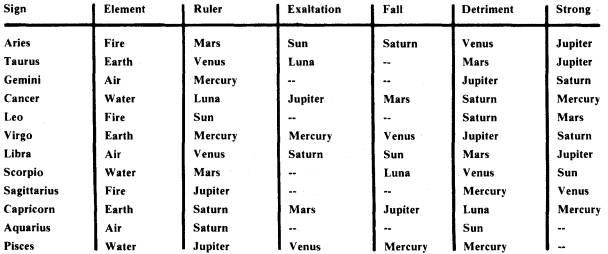
Caput Draconis is strong in the dignities of Jupiter and Venus.
Cauda Draconis is strong in the dignities of Saturn and Mars.

NOTES
The following notes were abstracted from a paper on Geomancy circulated in the A.O.,
which was the name given to the renewed Golden Dawn by Mathers years after the revolt.
In it, the statement is made that it was compiled by S.R.M.D. from ancient treatises:
1) Ye Geomancie of Maister Christopher Catton; a very old work in black letters.
2) The Theomagia by John Heydon (17th century). 3) And the Geomancia Astronomica of Gerardus CAM BRENSIS or Cremonensis.)
In each set of four lines of print, the First or Top line is attributed to the element FIRE (as being the most subtle element), the second line to the Air (the next in lightness), the third to the Water (more heavy), and the fourth and lowest line to Earth (the heaviest of all).
Further that each set of Four points signifieth an element, thus:
The first Four Lines signify FIRE; the second Four the element AIR; the third Four lines the element of WATER; and the fourth Four lines the element of EARTH.
In Geomancy there are three points which may tend a little to confuse the Practicus: (a) Why the Names and Seals of the SPIRITS of the Planets are employed instead of those of the INTELLIGENCES, the former being said to be more Evil in nature, and the latter More Good. (b) This being so, why the names and sigils of the Archangels of the Zodiacal Signs, purely Good in Nature, should be also employed; and instead of those of either the Angels, or Assistant Angels of the Zodiac. (c) There being 16 figures of Geomancy, and these under the 12 Signs, how are the 4 extra to be attributed in this classification.
(a) Geomancy being a form of Divination especially attributed to the Element of Earth, and therefore more purely Terrestrial in operation, the Spirits and their Characters are more naturally appropriate hereto than the Intelligences, as representing the more weighty and automatic force of the Planetary Ray in its action upon the Earth. Also the Sigils employed in Geomancy are different from those of the same Spirits when taken from the Kameas of the Planets, and this to affirm their more specialized action in this Art.
(b) The reason of the employment of such powerful Names as those of Malchidael, etc., is to bring a strong aiding Force of Good into the Operation, again specialized by the Sigils used in this connection.
(c) The 12 Governors of the 12 Zodiacal Ideas or Figures, have power over the face of the
Earth in their Figures and Places, but the 4 extra which be Fortuna Minor, Via, Caput
Draconis and Cauda Draconis, also naturally have reference to the Four Winds and their
Genii; a fortunate phase of the Moon (especially at Full) aspecting, is Good.
Gerardus Cremonensis sayeth: But you must always take heed, that you do not make a Question in a Rainy, very Stormy, cloudy, or very Windy Season; that is when the Elements be Angry; or when thou thyself art angry, or thy mind over-busied with many affairs; nor for tempters nor deriders, neither renew nor reiterate the same question again under the same Figure or Form; for that is Error.
YE COMPANIE OF HOUSES- From the Geomancie”ofMaister Christopher Cattan. When ye doe find a Good Figure in a good House, it is double Good, because the House is Good and the Figure also; and it signifieth that without any doubt the Querent shall obtain his Demand. By the like reason if ye find an Ill figure in an Ill House it is very Ill for the Querent. But if ye find a Good Figure in an Ill House, it Signifieth Good to the Querent but it will not continue, but taketh away part of the Malice of the House. In like case if ye find an Ill figure in a Good House, it taketh away the Malice of the Figure, for he would do harm, but he cannot; yet keeping back always the Good that it come not to the Querent.
By “Ill House” is meant that which in a Question shews persons or things opposed to the Querent or to his interest in the Question, as in a Lawsuit, The House shewing his Opponent; in a case of Sickness, the 6th and 8th would be hostile. “Good Houses” would be those shewing Aid etc. We might in a general sense consider the 6th, and 8th, (death) and the 12th (Fears, prison, private enemies), “Ill House” by Nature.
The “Companie of the Houses” is after three manners: SIMPLE, SEMI SIMPLE, and COMPOUND. And the House be classed in Pairs, thus: the Second House is always the Companion of the First; the Fourth of the Third; the Sixth of the Fifth, and so on.
The COMPANIE SIMPLE is when the same Figure is repeated in both Houses of any of the “Pairs.” Thus in our Scheme, VIA is repeated in the PAIR formed by the Ascendant and the Second House and they are therefore in COMPANY together. In this case shew that the indecision of the querent re-acts on his business. But though Caput Draconis is repeated in the Fourth and Fifth houses which be next each other, there is no COMPANY, for they belong to different pairs, the Fourth house being the Companion of the Third and not of the Fifth, and the latter being Company to the Sixth and not to the Fourth. And with regard to Persons, the COMPANION Figure will shew the COMPANIONS or Associates of a Person in question, as also will the COMPANION House. Good Figures in COMPANY show much Good, and as well in the Present as in the time to come; and Evil Figures the reverse. For also the First House (of a Pair) showeth the Time Present, and the Second the Time to Come.
The COMPANY DEMI SIMPLE is when the Figures in the Two Houses forming a Pair be not identical, but be under the same Planetary Ruler as Acquisitio and Laetitia which be both under Jupiter and Hismael, Fortuna Major and Minor under the Sun, Puella and Amissio under Venus, etc.
The COMPANY COMPOUND is when the Points of the Two Figures be the exact complementary contrary one of the other in arrangement as Puer and Puella, Albus and Rubeus, Acquisitio and Amissio, Laetitia and Tristitia, etc. A Reconciler figure is then formed from them in the same way that the Judge is calculated from the Two Witnesses, and according as this Figure is harmonized with such and Good, so is the nature of this “Company Compound,” but if discordant and evil so is this form of COMPANY.
There is also yet another kind of COMPANY which is that of the uppermost Line of the Two Figures in the Pair of Houses. If this uppermost line in both cases be odd or even, there is COMPANY, and as in the case of the COMPANY COMPOUND, a Reconciler Figure is formed and the case judged as in the last paragraph. But if the top line of the one be odd and the other be even there is no COMPANY between those Figures. In our Scheme Tristitia is in the Third and Caput in the Fourth House, and as the top line of each has even points there is COMPANY between them. The Reconciler Figure will be Conjunctio, which is Harmonious with Both and is an argument of Good being signified thereby.
The reference in the above to “our scheme” only means that Mathers had set up a divination in full, with its complete interpretation. I have not included it here because it would be redundant; one is already included in this text.
the Second are Fortuna Minor, Conjunctio, Albus which are not hostile to Career, therefore showing “opposition not great.”
The figure in the Fourth House is Fortuna Major which shows a good end but with anxiety. Let us now form a Reconciler between the figure of the Second House which is Career and the Judge, Populus, which produces Career again, a sympathetic figure, but noting delay, but helping the Querent’s wishes. Now let us add all these together:
1. Medium.
2. Evil and Obstacles, delay.
3. Loss through querent’s self.
4. Strength for evil, medium only.
5. Well-intentioned aid of friends.
6. Not much opposition from enemies.
7. Ending good; but with anxiety.
8. Delay, but helping Querent’s wishes.
And we can formulate the final judgment. That the Querent’s loss in business has been principally owing to his own mismanagement. That he will have a long and hard struggle, but will meet with help from friends. That his obstacles will gradually give way, and that after much anxiety he will eventually recoup himself from his former losses.
SUMMARY OF STAGES IN GEOMANTIC DIVINATION
1. If Rubeus or Cauda Draconis in Ascendant destroy the figure.
2. Note the House to which the question belongs. See if the figure there springs into another house.
3. Form the Judge from the two witnesses.
4. Part of Fortune that is, if a money question.
5. See if Figure in House concerned is “strong” or “weak.” If it pass or spring into any other house.
6. See figures Sextile and Trine, Square and Opposition.
7. Friendly or unfriendly.
8. Note the figure in Fourth House, signifying the end or outcome.
9. Form the Reconciler from Judge and the figure in House to which the demand appertains.